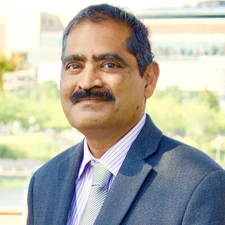Jothiram Vivekanandan

The 2018 Christiaan Huygens Medal is awarded to Jothiram Vivekanandan for his pioneering and ground-breaking work on the microphysical characterisation of clouds and precipitation by using advanced remote sensors.
Jothiram Vivekanandan is specialised in the development of theoretical methods, numerical models, data interpretation techniques and remote-sensing instruments for the characterisation of the microphysical properties of clouds and precipitation.
He has pioneered the development and implementation of novel methods and models applicable to polarimetric radar data for estimating precipitation rate and drop-size distribution, and for characterising ice and melting particles. He is the author of new fuzzy logic algorithms for hydrometeor particle identification. His studies paved the way towards the development of an innovative automated technique to classify polarimetric radar echoes into precipitation types, which he first operationally implemented in a new S-band polarimetric weather radar; nowadays, this automated technique is implemented by most manufacturers of weather radar systems in Europe, United States and Japan. Furthermore, based on the outcomes of Vivekanandan’s studies on the estimation of snowfall rate by using visibility, the Federal Aviation Administration of the US Department of Transportation has modified and improved de-icing procedures during snow storms.
Technology-wise, Vivekanandan is the leading inventor and developer of a ground-breaking dual-wavelength radar system, which combines a millimetre-wave radar and a S-band polarisation radar. This instrument led to new concepts and approaches for measuring cloud properties. In particular, by studying and interpreting the differences between the images recorded by the two radar systems, it has become possible to find tiny water droplets that were very difficult to distinguish by using either radar alone. Currently, multi-frequency systems are at the forefront of cloud and precipitation remote-sensing studies and this is another legacy of Vivekanandan’s research activity. Recently, he has directed the development of new cloud radar and C-band phased-array Doppler radar systems for aircraft, which are expected to enable a more accurate weather forecasting.
Vivekanandan is the Chief-executive editor of the EGU Geoscientific Instrumentation, Methods and Data Systems journal, an open-access interdisciplinary electronic journal for the publication of original articles and short communications in the area of geoscientific instruments.
Vivekanandan’s ongoing and impressive record of creative, inspiring and impactful scientific activities in applied geoscience, particularly in the fields of atmospheric remote sensing and meteorology, make him a deserving recipient of the EGU Christiaan Huygens Medal.
